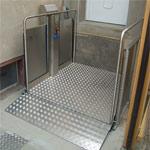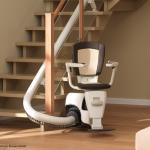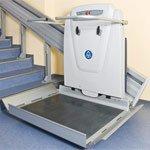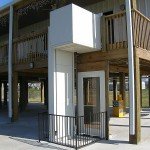Stair climbers can safely transport loads up or down stairs using a special wheel or caterpillar system. Compared to fixed stair lifts, they are much cheaper and can be transported without much effort.
The topic of accessibility is becoming increasingly important in today’s world – not least because of the steadily aging population. However, there are still many public institutions and private households that are not able to create a barrier-free environment for various reasons. This may be due to a staircase that is too winding and too steep, or it may fail for cost reasons.

But what options are there to support people with limited mobility? In addition to stairlifts, seat elevators and lifting platforms, an elevator can of course also help, but all these solutions are usually associated with very high costs and structural changes. An extremely practical and also inexpensive alternative is a stair climbing aid.
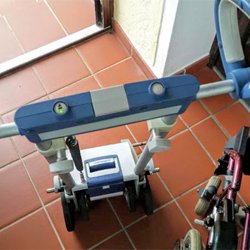
These are mobile devices that are frequently used by wheelchair users to overcome a wide variety of obstacles. The handy means of transport has a special wheel system that can be used to negotiate stairs without much effort – both up and down. A stair climbing aid is particularly suitable for wheelchair users, but can also be used for people with walking difficulties and older people who are no longer able to climb stairs independently. Another advantage of a stair climbing aid compared to permanently installed stairlifts is the almost unrestricted transportability of the unit. In addition, no changes to the building structure are necessary. However, another person must always be present for the use of a stair climbing aid.
Prices and costs
A stair climbing aid enables older people to enjoy a new lease of life. The initial cost depends on many different factors, so depending on the equipment and adaptation, the lift can be significantly cheaper or more expensive than previously thought.
Factors influencing price
The cost of a stair climbing aid is made up of many different factors. Among other things, it depends on which model you choose, which drive is required and what additional equipment the lift should have. Furthermore, the price is also calculated according to the height to be overcome and the load capacity. In addition, the lift must be adapted to the structural and personal situation of the customer. Basically, therefore, a stair climbing aid is in most cases a custom-made product. In summary, the following factors drive the total price up further:
Nr. | Cost factors |
|---|---|
| 1. | Complexity and angle of inclination of the stairs |
| 2. | Number of steps |
| 3. | Effort during installation |
| 4. | Height to be overcome |
| 5. | Additional equipment and optics |
| 6. | Weather resistance for outdoor installation |
| 7. | Load capacity and load bearing capacity |
| 8. | Driving speed |
| 9. | Number of breakpoints |
| 10. | Type of drive (electric motor, traction drive, rack and pinion drive / gear drive) |
The aforementioned factors thus ensure that manufacturers are generally unable to provide any blanket price information. At present, the average price range for a stair climbing aid for one floor is around 5,000 to 10,000 €. Used models are already available for less than 3,000 €, but it is important to pay close attention to whether the model is suitable at all. When buying a new stair climbing aid, a manufacturer can only provide a cost estimate after an on-site inspection. In addition, you should consider in advance whether the stair climbing aid must also have special or adapted equipment. This way, the manufacturer can provide a quote that is perfectly tailored to your needs.
Acquisition costs
A stair climbing aid often enables barrier-free access without extensive reconstruction of the living environment. It can be installed within a very short time and is cheaper to purchase than conventional elevators. When buying a stair climbing aid, one should expect costs of at least 5,000 €. These prices are standard market prices and do not refer to a single manufacturer. For a single-family house with 1 floor and larger conversion costs, prices of up to 10,000 € can quickly arise. If the stair climbing aid is installed for a wheelchair user, a subsidy of up to 4,000 € can be applied for and claimed from the care insurance if a corresponding nursing care degree is available.
Lift type | Stair form | Area | Price |
|---|---|---|---|
| Stairlift | straight stairs | Inside | 3,800 to 9,700 € |
| Stairlift | curved stairs | Inside | 8,000 to 15,000 € |
| Stairlift | straight stairs | Outside | 4,000 to 7,500 € |
| Platformlift | Straight stairs | Inside | 9,000 to 15,000 € |
| Platformlift | curved stairs | inside | 12,000 to 25,000 € |
| Platformlift | Straight stairs | Outside | 9,000 to 15,000 € |
| Platformlift | Curved stairs | Outside | 15,000 to 25,000 € |
| Lifting Platform | Height up to 1.79m | Outside | 8,000 to 15,000 € |
| Lifting Platform | Height up to 3m | Exterior | from 17,500 € |
The price of a stair climbing aid depends on various factors e.g. the load capacity, the driving speed, the number of stopping points, the height, the type of drive, the model and the appearance. Outdoor stair climbing aids are understandably more expensive than indoor ones. The real purchase costs can be determined very accurately by several cost estimates from different lift manufacturers -and service providers. An incalculable size remains however the costs of the necessary rebuilding measures at the single family house. If larger excavations are necessary at the single-family dwelling, additional costs can develop. Therefore, before buying a stair climbing aid, find out about “all” the costs involved and financial subsidies. In addition to the care cost subsidy for measures to improve the individual living environment, the state-subsidized KfW Bank promotes measures to reduce barriers with favorable loans of up to 50,000 €.
Prices and customization options vary widely from manufacturer to manufacturer. There are no blanket price quotations such as a price per 1 meter height or per stair step. Generally speaking, the more steps it has to climb and the more weight it has to carry, the more expensive it is. For each additional meter, you should expect to pay at least 2,000 € more, not including costs for conversion work. A stair climbing aid that is attached to the outside staircase, has a rail length of around 2 meters, has 2 holding points, moves via a hydraulic drive and can be used by a wheelchair user should cost at least 8,000 € with installation. The purchase is costly and should be carefully planned. A price comparison via Treppenlifto.de can save a lot of money. You will receive up to three free and non-binding offers from stairlift providers in your region, which you can compare at your leisure and without risk.
Costs for maintenance and servicing
Stair climbing aids are low-emission, durable, lightweight and space-saving. A stair climbing aid only needs to have its oil and seals changed every 5 years. The material required for this is freely available and costs around 100 €. For the professional implementation of the oil -and seal change, one should expect costs of about 500 €. The cost of labor for maintenance is about 1,000 €. As a rule, a partial or full maintenance contract is concluded with the lift manufacturer from whom the stair climber is purchased to cover maintenance for a period of five or ten years. The costs for maintenance, inspection, cleaning, lubrication, adjustment work and the replacement of wear parts are then usually regulated on a flat-rate basis.
Energy costs
The energy costs for a stair climbing aid are made up of the consumption during trips and standby times. For a stair climbing aid in a single-family house with 1,500 trips per year, i.e. approximately 4 trips per day, one should expect energy costs of 200 kWh standby power and 100 kWh travel power. At an electricity price of 0.26 €/kWh, this results in annual costs of approx. 78 €. Platform lifts in single-family homes stand still 99% of the time. The energy costs therefore depend primarily on how much the elevator is used, whether the drive installed is suitable for the particular usage situation and what height the stair climbing aid has to climb. As a rule, more than 50% of the power consumption of stair climbers is consumed in standby mode. To save energy costs, you should make sure that LED lamps are used instead of halogen or incandescent lamps and that there is a timer function for lighting and electronics.
Rent or installment
Many manufacturers also offer the option of renting the stairlift or paying it off monthly in installments. Here it is advisable to compare the prices of the various providers in detail and in peace with each other – this saves money. Furthermore, it can not hurt if you also talk to your bank advisor about a financing model. In some cases, a bank loan may have lower interest rates than a loan through the respective lift manufacturer. In addition, an on-site inspection and cost estimate should be non-binding and free of charge.
Stair climbing aids for wheelchairs

A stair climbing aid is primarily a transport device for people with limited mobility. It has a special wheel system, often called a caterpillar system, because it consists of several wheels of different sizes. The special arrangement of these wheels allows the mobility-impaired person to be transported up or down the stairs without any great effort – even at an angle of inclination of up to 70 percent.
Stair climbing aids offer a support aid, which is located underneath the device and ensures load compensation during transport. This means that there is no risk of the stair climber slipping off the stair tread at any time. These devices are available in various model designs that can be used for different purposes. For transporting a wheelchair user, the most suitable device is a climbing aid that can be attached directly to the backrest of the wheelchair.
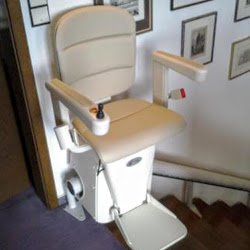
For people with limited mobility who are not dependent on a wheelchair, stair lifts with a permanently installed seat are used. In most cases, this seat is height-adjustable and provides secure support at all times thanks to armrests and footrests. Above the headrest is a handle system that allows the attendant to hold and move the device. The handles are made of non-slip rubber that prevents hands from slipping. Likewise, stair climbing aids have a small electric motor that acts as an additional power booster. To power this motor, a powerful rechargeable battery is usually used.
Advantages of stair climbing aids
A stair climbing aid offers many advantages over a stair lift or hoist. For one thing, it does not have to be permanently installed, so no remodeling work needs to be done in or on the house.
Secondly, the device is very easy to transport, as most models can be folded. In addition, due to its design, a stair climbing aid does not have a high dead weight (usually between 20 and 70 kilograms) and can therefore be easily operated and transported even by older people.
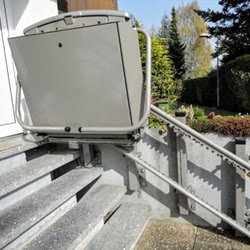
Stair climbing aids can be used without permission. This means that you can buy and use such a device at any time without having to pay attention to legal regulations. Likewise, mobile stair climbing aids can be attached to almost any commercially available wheelchair. The assembly is very simple and can be implemented within a few minutes. Furthermore, a climbing aid can be used not only indoors but also outdoors. The devices are extremely robust and also waterproof. Another advantage is the price.

Depending on the model and equipment, stair climbing aids cost significantly less than a stair lift and are often subsidized by health insurance or social welfare. The functionality of a stair climbing aid is self-explanatory and the handling can be learned within a very short time. The devices can be used on almost all stairs – even very steep, winding or narrow staircases. However, the width of the stairs should be at least 70 centimeters.
Costs, prices and alternatives
The price of a stair climbing aid depends on several factors. Therefore, the cost of such a device can be determined only in rudimentary. On average, mobile climbing aids cost between 1,000 and several thousand €. Here it depends on whether the device is equipped with a seat and must offer additional functions. In any case, it is worth comparing the various manufacturers, as prices vary greatly.

Conveniently, more and more manufacturers now offer stair-climbing aids for rent. This amounts to an average of around 100 € per month. The advantage here is that you can return the climbing aid at any time without loss of value. Another way to reduce the price to an acceptable level is to purchase a used mobility solution. While stair lifts or hoists are rarely offered second-hand due to their individual design, this problem is extremely rare with stair climbing aids.
You can buy a used stair climber for as little as a few hundred € on eBay Classifieds. Here you should make sure that the device is in perfect condition and that a warranty is guaranteed. The latter is often not given in private sales. For this reason, it is recommended to buy a used stair climber from a commercial dealer. This guarantees the safety of the device through regular maintenance and is also obliged to offer a warranty for reconditioned devices.
Statutory health insurance and care insurance
Stair-climbing aids are registered in the official list of aids of the statutory health insurance funds. Their purchase is therefore also subsidized. However, in some cases, the health insurance company may refuse to cover the costs. Since the health insurance companies examine each financing request individually, it is not possible to say in advance whether the costs will actually be covered. For this reason, it is advisable to contact your own health insurance company before purchasing a climbing aid. Often, in addition to a medical certificate, a cost estimate must also be submitted. This should also be sent to the insurance company before the purchase.
After the health insurance company has examined the case individually and approved a subsidy, you can usually expect to have the costs covered by up to 4,000 €. In some cases, the costs for the purchase are also covered by the responsible social welfare agency. Here, too, both a certificate from the attending physician and a cost estimate are required. Furthermore, the applicant must be registered as a social welfare recipient. In order to avoid unnecessary complications already during the application process, you should inform yourself in advance about the exact procedure with the responsible employee of the social welfare office.
Average equipment
The technical specifications of individual models vary greatly. For this reason, we list the average values without special optional equipment below. A stair climber can usually be loaded with a person weight of 120 kg to 165 kg. This limitation is due to the fact that the built-in electric motor can only work without restrictions up to a certain load point, thus guaranteeing unrestricted safety. The motor normally offers a power of up to 275 watts and is powered by one or two accumulators. Depending on the setting and power, a stair climber reaches a climbing speed of 8 to 23 steps per minute. Thanks to the special lightweight construction, the stair aids weigh only about 20 to 70 kilograms.



